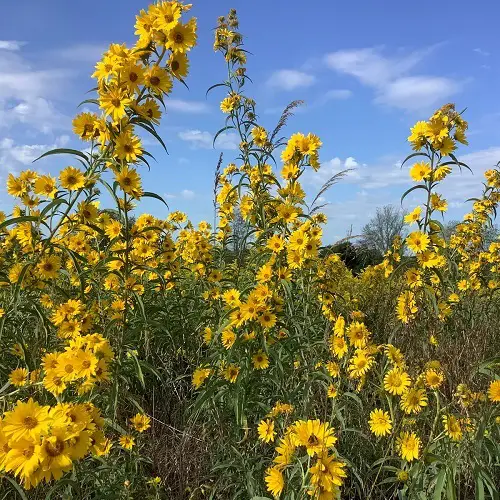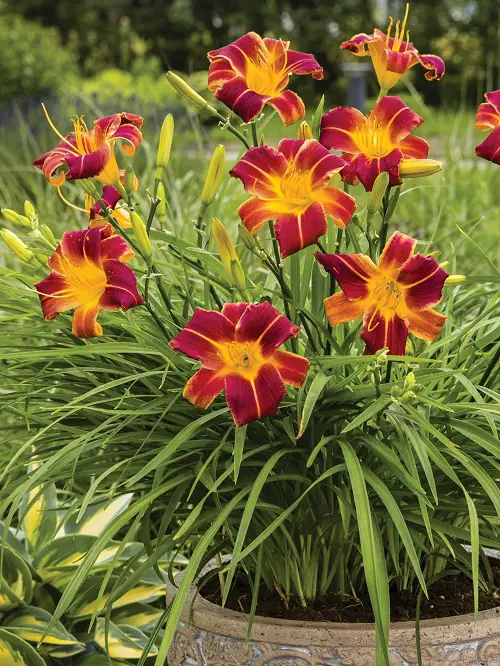Grow these Tall Perennial Flowers for background planting, privacy, and to create vertical interest and drama!
Rising above the rest, they become a great focal point, look glamorous, shield the little ones from too much sun or rain, and provide a lush privacy cover from nosy outsiders.
But most of all, if you grow them, your garden will finally break its stuffy shackles and emerge tall, with oodles of pizzazz!
Tall Perennial Flowers
1. Canna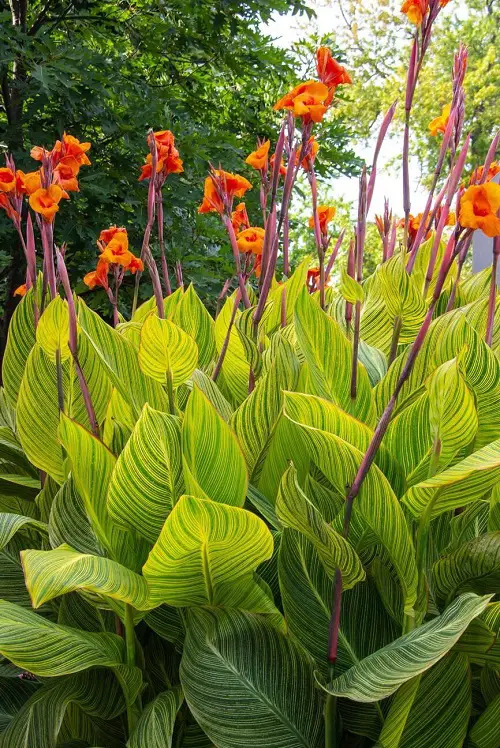
Botanical Name: Canna
USDA Zones: 8 to 11
Growing up to around 6 feet in height, Canna is a tall perennial with large, banana-like leaves that vary in color–from lime green to burgundy–and feature solid or variegated patterns of stripes or spots. Canna flowers form dense clusters on top of tall stalks in shades of red, pink, orange, yellow, and a combination of hues.
These perennials grow best in temperate and frost-free climates. They need full sun, organic-rich, fertile soil, warmth, and ample hydration to spread their beauty in fall and summer!
2. Delphinium
Botanical Name: Delphinium
USDA Zones: 3-7
Delphiniums will surely get your attention with racemes of blue, purple, and white blooms. Reaching up to 3 feet tall, some sub-varieties are known to grow even taller.
Make sure you admire these tall perennials from a distance, though. They are poisonous, causing severe pain if ingested and potentially leading to fatalities. Despite their toxicity, many gardeners grow varieties of these pretty flowers for their obvious beauty!
3. Peonies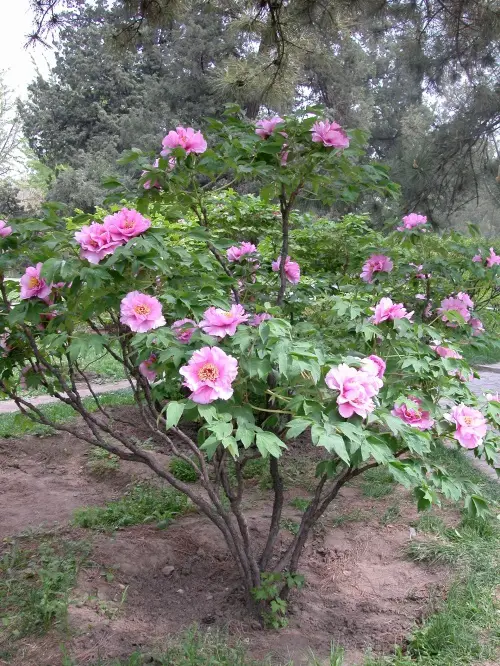
Botanical Name: Paeonia
USDA Zones: 3-8
No list of tall perennial flowers can be complete without our classic peonies! These flowering plants can reach 3-4 feet tall and bear large, fragrant, ruffled blooms in pink, red, gold, and white.
Peonies are hardy and long-lived, often thriving in the same spot for decades, sometimes over 100 years! These tall perennials prefer full sun and loamy soil and, surprisingly, thrive on neglect!
4. Blazing Star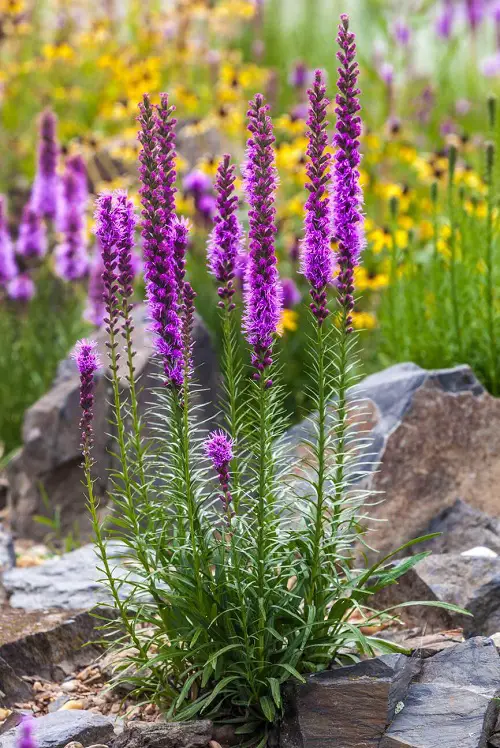
Botanical Name: Liatris spicata
USDA Zones: 3-9
If you thought the name was intriguing, wait until you grow the plant! The Blazing Star is a tall perennial reaching over 4 feet tall. Its bottlebrush-like dense purple spiky blooms grow upright and erect, with narrow grassy leaves along its stalk.
Blooming from summer to fall, these long-lasting perennial flowers need full sun and well-drained soil to grow. Once established, they’re tough and can handle hot, dry weather. They also don’t need much water.
5. Foxglove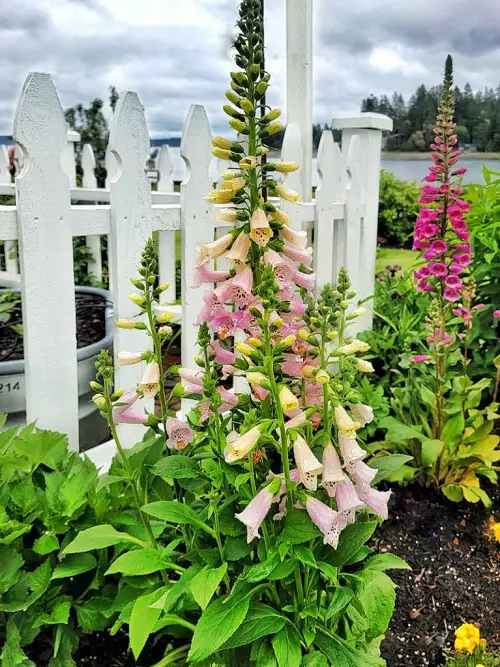
Botanical Name: Digitalis purpurea
USDA Zones: 3-10
Native to Europe, Foxgloves are as beautiful as they are deadly. Don’t let their 6-foot-tall stature and colorful tube-shaped blooms fool you; these perennials contain high quantities of cardiac glycosides, which can lead to heart failure if ingested! But its pastel-hued blooms in pink, purple, cream, and yellow do attract hummingbirds and bees.
These tall flowering perennials enjoy full sun to partial shade and are not fussy about soil. They’ll grow in the most well-drained types as long as it’s slightly moist, like a squeezed sponge, and not soggy.
6. Yellow Flag Iris
Botanical Name: Iris pseudacorus
USDA Zones: 5-9
Yellow Flag Iris grows up to 4 feet tall and sports sword-like leaves with bright yellow fan-shaped flowers on top. Typically found in marshy bogs, along riverbanks, and in wetlands, this species is highly invasive and grows fast.
Prune regularly to prevent them from colonizing other vegetation. This tall perennial thrives in moist soil and enjoys partial shade. However, it cannot survive dry conditions.
7. Catmint
Botanical Name: Nepeta
USDA Zones: 3-8
A purrfect gift for your feline friends, catmint is an herbaceous perennial that cats go nuts for! Native to Europe and Asia, catmint has traditionally been used by humans for its medicinal properties. Growing up to 3 feet tall, it is often confused with Lavender from a distance due to its identical racemes of purple blooms.
Drought-tolerant and deer-resistant, catnip is also known to deter pests like aphids and squash bugs and repel mosquitoes. Grow it in full sun, and this tall flowering perennial will keep you and your cat satisfied with foliage and blooms!
8. Hollyhock

Botanical Name: Alcea
USDA Zones: 4-9
Even the tallest humans look small in front of the mighty Hollyhock. Often reaching up to 8 feet in height, Hollyhock produces large, colorful blooms in pink, red, and yellow. But, as the saying goes, the bigger they are, the harder they fall–these tall perennial flowers need support and protection from strong breezes so they don’t topple over.
Plant these short-lived perennial giants in full sun and compost-rich, well-drained soil with adequate spacing. Deadhead spent flowers regularly to ensure recurring blooms.
9. Russian Sage

Botanical Name: Perovskia atriplicifolia
USDA Zones: 4-9
Try guessing where the perennial Russian Sage is originally from. This aromatic plant actually comes from Central and Western Asia and is named after B. A. Perovski, the Turkestani governor of the Russian province who advocated the study of Central Asia.
Growing up to 4 feet, these tall clusters of purple perennial flowers bloom in slender spikes with fragrant silver-gray leaves. It thrives in full sun to partial shade, is drought-tolerant, and can tolerate rocky soils.
10. Achillea
Botanical Name: Achillea millefolium
USDA Zones: 3-9
Also called yarrows, this plant is named after the Greek hero Achilles, who used it to heal wounds during the Trojan War. This amazing medicinal plant with red, white, yellow, orange, and magenta flowers reaches up to 3 feet tall.
It can be propagated from seeds or by division, and its flowers are often used in floral decoration due to their ability to retain their charm after being cut and dried.
Easy to grow, achillea is drought-tolerant and prefers full sun. Cut back the entire plant after flowering to encourage new growth.
11. Maximilian Sunflower
Botanical Name: Helianthus maximiliani
USDA Zones: 3-10b
Named after Prince Maximilian of Germany, this iconic flowering perennial grows to a gigantic size of 10 feet. It produces bright yellow daisy-shaped blooms from mid-summer through fall and spreads via rhizomes and seeds.
Thriving in full sun, it can tolerate a range of well-drained soil types and is relatively drought-tolerant.
12. Wild Indigo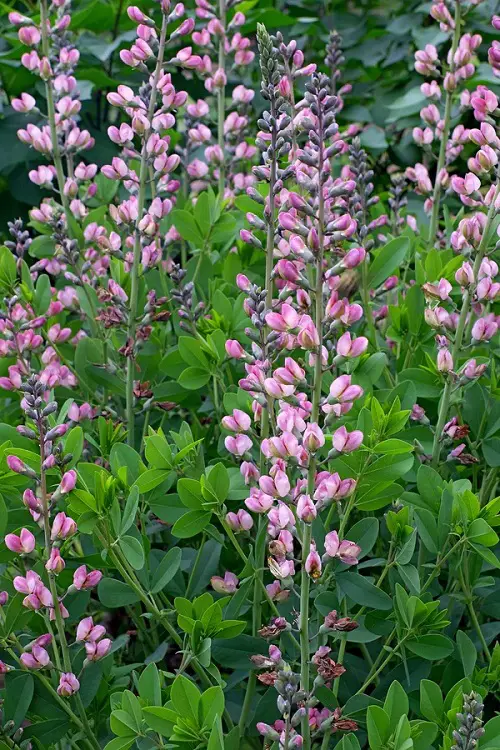
Botanical Name: Baptisia
USDA Zones: 3-10
Wild indigo is an herbaceous perennial with spikes of pea-shaped blooms in shades of blue, purple, and white and its unique trifoliate leaves. Reaching heights of up to 4-5 feet, this plant is famous for the blue dye extracted from its flowers.
Thriving in full sun, this hardy perennial can tolerate drought, dry and poor soil, and even erosion once mature.
13. Globe Thistles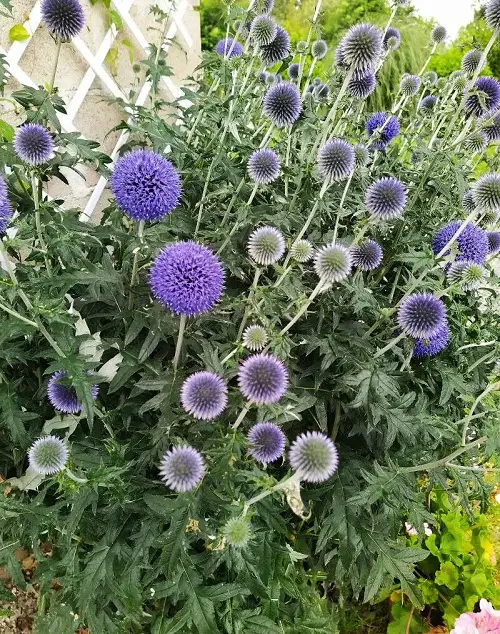
Botanical Name: Echinops ritro
USDA Zones: 3-9
If you spot a plant with tiny, poky blooms growing atop long, slender stems, you have chanced upon the globe thistle. It produces globe-like blue and white flower heads comprising individual clusters of star-shaped blossoms.
Blooming very long from summer to fall, plant these in a spot with at least 6 hours of direct sunlight daily in well-drained soil.
14. Oriental Lily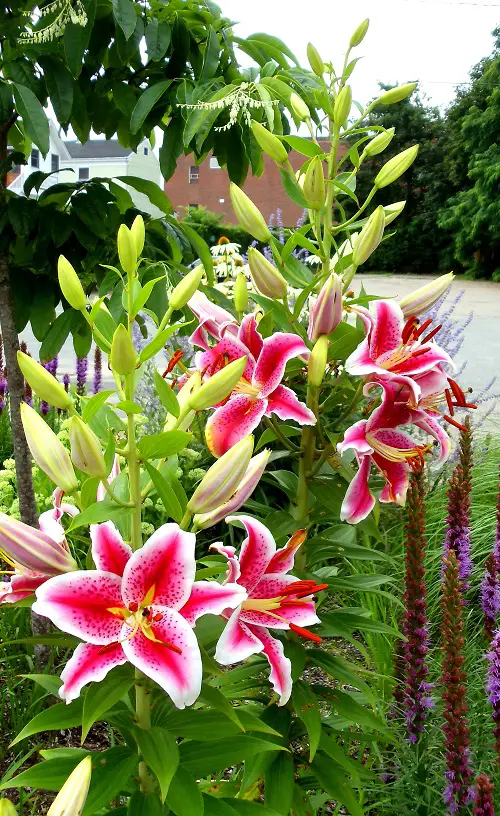
Botanical Name: Lilium orientalis
USDA Zones: 4-9
Want beauty, height, and fragrance? The oriental lily is the plant for you! This classic floral pick grows to about 3-4 feet and has large, fragrant white, pink, and red trumpet-shaped flowers with lance-shaped lush green foliage.
These tall flowering perennials prefer full sun, well-drained, organic-rich soil, and consistent watering.
15. Joe Pye Weed
Botanical Name: Eutrochium
USDA Zones: 4-8
Also known as the Queen of the Meadow, Joe Pye Weed is a herbaceous perennial that touches an average of 5-6 feet in height but can also go over that. In late summer, it develops small, pinkish-purple flowers that attract many butterflies.
Preferring sunshine through the morning and some shade for its afternoon siesta, this North American native grows well in moist to wet, fertile soil. Remember, too much shade can make them weak and floppy.
16. Red Hot Poker
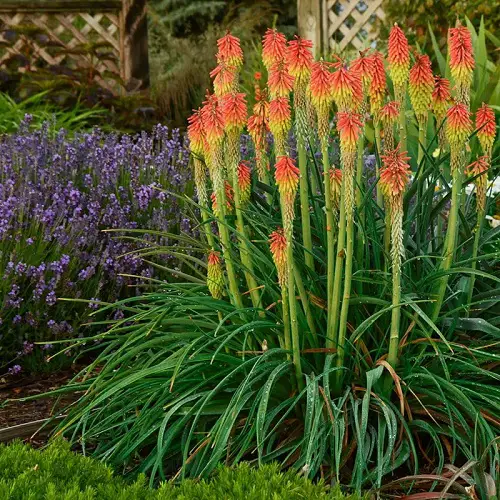
Botanical Name: Kniphofia
USDA Zones: 6-9
The Red Hot Poker has elongated columns of tubular flower clusters in gradient hues of fiery red, orange, and yellow. The dwarf varieties are only 1 foot tall, whereas others can grow up to 6 feet.
These flowering perennials should be watered deeply during long dry spells and when establishing, but otherwise, they are pretty hardy to drought. Ensure the soil drains well, and expose them to plenty of sunlight to get the best blooms of the season. Here’s everything about growing and caring for them.
17. African Lily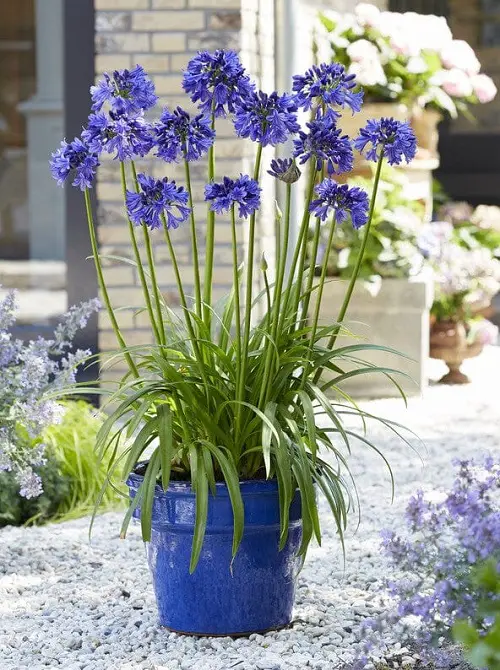
Botanical Name: Agapanthus
USDA Zones: 8-11
Known by different names, such as Agapanthus or Lily of the Nile, the African Lily is a tall perennial that calls South Africa home. Its height varies, but some plants may grow up to 6 feet. It is known for its large clusters of blue or white bell-shaped flowers that bloom during summer through fall in warm weather.
In extreme heat, African Lily needs consistent moisture and a full morning sun with shade in the afternoons. It thrives in a well-drained, fertile, loamy soil.
18. Perennial Hibiscus
Botanical Name: Hibiscus
USDA Zones: 4-11
When it comes to height, color, shape, and personality, Hibiscus is the master of all. If you live in a hot climate, you can grow tropical hibiscus, and if you reside in a cold climate, plant hardy hibiscus or rose of Sharon.
These small shrubs typically reach 8 feet in height, showing plate-sized magenta, scarlet, yellow, orange, blue, and creamy blooms that steal the spotlight in an instant.
These blooms last for a day, but the plant flowers throughout the year in warm regions and summer to fall in colder parts. It prefers full sun and organic-rich soil. Mulch around its base during hot and dry periods to keep it consistently moist.
19. Black-Eyed Susan

Botanical Name: Rudbeckia
USDA Zones: 3-11
Black-eyed Susan is essentially friendly, nectar-filled daisies on steroids! It can grow up to 6 feet, which is three times the size of an average daisy plant.
Plant this sunny yellow flowering perennial around spring or early fall. It prefers full sun and tolerates clay soil well. Once mature, it also becomes drought tolerant.
20. Daylily
Botanical Name: Hemerocallis
USDA Zones: 4-9
Daylilies are herbaceous perennials often grown in clumps. They are usually only a foot tall, but in the best conditions, they can grow to 4 times that size. The interesting name comes from their attractive trumpet-shaped blooms, which last only a single day before wilting.
Daylilies can tolerate just about any soil as long as it is well-draining. You should plant it in full sun for the most blooms.



